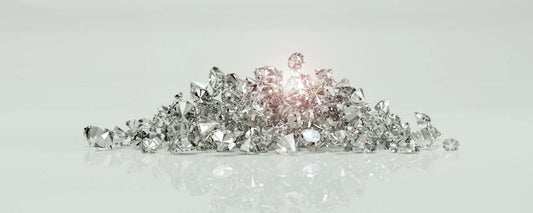What Is Diamond Clarity?
Clarity refers to the purity of a diamond and is one of the main grading items. The inclusions and blemishes of a diamond are like the "birthmarks". The laboratory will grade the quality of the diamond according to the nature, number, size, position and color of these "birthmarks". The fewer inclusions and blemishes, the higher the clarity and hence the higher the value of the diamond.
Diamond Clarity Grade
Diamond clarity is divided into six grades: Flawless (FL), Internally Flawless (IF), Very Very Slightly Included (VVS), Very Slightly Included (VS), Slightly Included (SI), and Included (I). The main factor that impacts the clarity grade is the inclusions of the diamond. While blemishes on the diamond surface generally have minor influence on the clarity grade and value of the diamond.

- FL(Flawless)– No inclusions or blemishes are visible under 10x magnification
- IF(Internally Flawless)– No inclusions are visible under 10x magnification, only blemishes that can be seen by professional graders
- VVS1 & VVS2(Very Very Slightly Included)– Even a professional grader can hardly see the inclusions under 10x magnification
- VS1 & VS2(Very Slightly Included)– Tiny inclusions can be observed under 10x magnification
- SI1(Slightly Included)– Inclusions can be easily observed under 10x magnification
- SI2(Slightly Included)– Inclusions can be carefully observed with the naked eye
- I1(Included)– Inclusions are clearly visible to the naked eye and in many cases are likely to affect the diamond's transparency, brilliance and structure
- I2 & I3(Included)– Inclusions are visible to the naked eye and generally affect diamond's transparency, brilliance and diamond. Diamond Culture does not sell diamonds of this quality
The Importance of Inclusions
Inclusions are features within a diamond that are resulted from different experiences during the formation of natural and lab grown diamonds. There are some differences between the inclusions of natural and lab grown diamonds. Precise analysis of the inclusions can deduce a diamond's unique history and treatment. In natural diamonds, inclusions help us better understand where the diamond originated and how it was formed; in lab-grown diamonds, they help determine the growth method. Most importantly, inclusions help differentiate lab grown diamonds from natural diamonds.
Natural Diamonds
As natural diamonds crystallize in the Earth mantle, internal inclusions become part of the diamond as the diamond deforms its structure during growth. Clarity characteristics make each diamond unique, and it is almost impossible that two diamonds have the exact same inclusions in the same position. Inclusions such as crystal, knot, twinning wisps, natural and indented natural are all evidence of natural diamonds.

Crystal – Minerals contained in diamonds are common inclusions that come in different sizes and colors.

Knot – A white or transparent diamond crystal that extends to the surface after fashioning.

Twinning Wisp – A series of pinpoints, clouds, or crystals that forms in a diamond’s growth place; associated with crystal distortion and twinning planes.

Natural – A portion of the rough diamond’s original surface that is left on a polished diamond’s surface.
HPHT Lab Grown Diamond
Diamonds grown in the laboratory by HPHT method require the use of catalysts. Typical catalysts include iron, nickel, cobalt or other metals. Diamonds produced by HPHT method may "trap" a certain amount of metal inclusions formed by the catalyst flux during the formation process. In reflection of light, these inclusions appear white, grey or black with a metallic sheen. Inclusions can appear either singly or in small groups.

Metal flux inclusions come in a variety of shapes, including rods, irregular shapes, and some with attached cracks.

Cloud with small round metallic crystals (left) and fine needles (right).

Black triangular growth characteristics.

Triangular growth characteristics with hair-like inclusions (left) and large metallic inclusions with a cloud of tiny dots (right).
CVD Lab Grown Diamond
The CVD method of culturing diamonds takes place in a vacuum chamber filled with a gas mixture. Gases such as hydrogen and methane are activated by microwaves, releasing carbon atoms that are deposited layer by layer on the diamond's substrate. CVD diamonds are free of metallic inclusions. Instead, they often contain dark graphite or other mineral inclusions as a result of their unique growth process. Graphite inclusions look different from metals because they don't have a metallic luster. Inclusions in CVD diamonds, usually non-diamond carbon, appear as small black particles or crystals.

Feathers of non-diamond carbon.

Irregular black inclusions composed of non-diamond carbon.

A cloud of small black particles.
Plot of Inclusions in a Diamond Grading Report
The diamond grading reports for diamonds of 1.00ct or above usually come with a plots. Inclusions are marked in red and blemishes in green. Dominant features that have an impact on the clarity grade are marked on the plot and are very useful for distinguishing diamonds. Whereas minor inclusions are often only written into comments.

Diamond plot in an IGI Lab Grown Diamond Grading Report

Diamond plot in a GIA Lab Grown Diamond Grading Report





